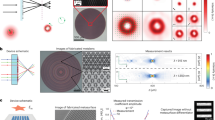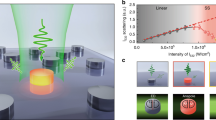Abstract
There has been an escalation in interest in developing methods to control the near field because of its role in subwavelength optics. Many novel ideas have emerged in the field of plasmonics1, super-resolution optical imaging2,3,4,5 and lithography6, among others. However, the near field generated in plasmonic metamaterials is fundamentally restricted by their predesigned structure, and super-resolution optical techniques do not directly control the near field. Here, we achieve direct control of the optical near field by shaping the wavefront impinging on turbid media consisting of random nanoparticles. The linear relation between input far field and scattered output near fields allows us to coherently control the near field at arbitrary positions. Direct control of the near field through scattering control offers novel approaches for subwavelength optics and may have direct applications in bio- and nanophotonics.
This is a preview of subscription content, access via your institution
Access options
Subscribe to this journal
Receive 12 print issues and online access
$209.00 per year
only $17.42 per issue
Buy this article
- Purchase on Springer Link
- Instant access to full article PDF
Prices may be subject to local taxes which are calculated during checkout





Similar content being viewed by others
References
Schuller, J. et al. Plasmonics for extreme light concentration and manipulation. Nature Mater. 9, 193–204 (2010).
Rust, M. & Bates, M. Sub-diffraction-limit imaging by stochastic optical reconstruction microscopy (STORM). Nat. Methods 3, 793–795 (2006).
Klar, T. & Hell, S. W. Subdiffraction resolution in far-field fluorescence microscopy. Opt. Lett. 24, 954–956 (1999).
Gustafsson, M. G. L. Nonlinear structured-illumination microscopy: wide-field fluorescence imaging with theoretically unlimited resolution. Proc. Natl Acad. Sci. USA 102, 13081–13086 (2005).
Betzig, E. et al. Imaging intracellular fluorescent proteins at nanometer resolution. Science 313, 1642–1645 (2006).
Brimhall, N., Andrew, T., Manthena, R. & Menon, R. Breaking the far-field diffraction limit in optical nanopatterning via repeated photochemical and electrochemical transitions in photochromic molecules. Phys. Rev. Lett. 107, 1–5 (2011).
Betzig, E. & Trautman, J. K. Near-field optics: microscopy, spectroscopy, and surface modification beyond the limit diffraction. Science 257, 189–195 (1992).
Pendry, J. B., Aubry, A., Smith, D. R. & Maier, S. A. Transformation optics and subwavelength control of light. Science 337, 549–552 (2012).
Fang, N., Lee, H., Sun, C. & Zhang, X. Sub-diffraction-limited optical imaging with a silver superlens. Science 308, 534–537 (2005).
Liu, Z., Lee, H., Xiong, Y., Sun, C. & Zhang, X. Far-field optical hyperlens magnifying sub-diffraction-limited objects. Science 315, 1686 (2007).
Gjonaj, B., Aulbach, J., Johnson, P. & Mosk, A. Active spatial control of plasmonic fields. Nature Photon. 5, 360–363 (2011).
Lerosey, G., De Rosny, J., Tourin, A. & Fink, M. Focusing beyond the diffraction limit with far-field time reversal. Science 315, 1120–1122 (2007).
Apostol, A. & Dogariu, A. Spatial correlations in the near field of random media. Phys. Rev. Lett. 91, 1–4 (2003).
Carminati, R. Subwavelength spatial correlations in near-field speckle patterns. Phys. Rev. A 81, 1–5 (2010).
Emiliani, V. et al. Near-field short range correlation in optical waves transmitted through random media. Phys. Rev. Lett. 90, 25–28 (2003).
Dainty, J. C. (ed.) Laser Speckle and Related Phenomena (Springer-Verlag, 1975).
Vellekoop, I. M. & Mosk, A. P. Focusing coherent light through opaque strongly scattering media. Opt. Lett. 32, 2309–2311 (2007).
Hell, S. & Stelzer, E. H. K. Properties of a 4Pi confocal fluorescence microscope. J. Opt. Soc. Am. A 9, 2159–2166 (1992).
Rogers, E. T. F. et al. A super-oscillatory lens optical microscope for subwavelength imaging. Nature Mater. 11, 1–4 (2012).
Park, J., Park, C., Yu, H., Cho, Y. & Park, Y. Dynamic active wave plate using random nanoparticles. Opt. Express 20, 17010–17016 (2012).
Park, J., Park, C., Yu, H., Cho, Y. & Park, Y. Active spectral filtering through turbid media. Opt. Lett. 37, 3261–3263 (2012).
Aulbach, J., Gjonaj, B., Johnson, P., Mosk, A. & Lagendijk, A. Control of light transmission through opaque scattering media in space and time. Phys. Rev. Lett. 106, 5–8 (2011).
Katz, O., Small, E., Bromberg, Y. & Silberberg, Y. Focusing and compression of ultrashort pulses through scattering media. Nature Photon. 5, 372–377 (2011).
McCabe, D. J. et al. Spatio-temporal focusing of an ultrafast pulse through a multiply scattering medium. Nat. Commun. 2, 447 (2011).
Van Putten, E. G. et al. Scattering lens resolves sub-100 nm structures with visible light. Phys. Rev. Lett. 106, 193905 (2011).
Vellekoop, I. M., Lagendijk, A. & Mosk, A. P. Exploiting disorder for perfect focusing. Nature Photon. 4, 320–322 (2010).
Choi, Y. et al. Overcoming the diffraction limit using multiple light scattering in a highly disordered medium. Phys. Rev. Lett. 107, 1–4 (2011).
Lerosey, G. et al. Time reversal of electromagnetic waves. Phys. Rev. Lett. 92, 19–21 (2004).
Derode, A., Roux, P. & Fink, M. Robust acoustic time reversal with high-order multiple scattering. Phys. Rev. Lett. 75, 4206–4210 (1995).
Lemoult, F., Fink, M. & Lerosey, G. A polychromatic approach to far-field superlensing at visible wavelengths. Nat. Commun. 3, 889 (2012).
Acknowledgements
The authors thank Y.-H. Lee, J.H. Shin, M.-K. Seo and B.Y. Kim for helpful discussions. This work was supported by KAIST, the KAIST Institute for Optical Science and Technology, the Korean Ministry of Education, Science and Technology (MEST; grant no. 2009-0087691, Basic Research Lab (BRL)), the National Research Foundation (NRF-2012R1A1A1009082, NRF-2012K1A3A1A09055128, NRF-2012-M3C1A1-048860, NRF-2012R1A1A2022754). The Pioneer Research Center Program (2013M3CIA3000499), and World Class University (WCU) program (No. R31-2008-000-10071-0) of the Ministry of Education, Science and Technology. Y.K.P. acknowledges support from TJ ChungAm Foundation.
Author information
Authors and Affiliations
Contributions
J.-H.P. and C.P. performed the experiments and analysed the data. H.Y., J.S., J.P., S.H., S.H.K. and K.T.N. contributed new reagents and analytic tools. Y.-H.C. and Y.P. conceived and supervised the project. J.-H.P., C.P., Y.-H.C. and Y.P. wrote the manuscript, with contributions from all co-authors.
Corresponding authors
Ethics declarations
Competing interests
The authors declare no competing financial interests.
Supplementary information
Supplementary information
Supplementary information (PDF 912 kb)
Rights and permissions
About this article
Cite this article
Park, JH., Park, C., Yu, H. et al. Subwavelength light focusing using random nanoparticles. Nature Photon 7, 454–458 (2013). https://doi.org/10.1038/nphoton.2013.95
Received:
Accepted:
Published:
Issue Date:
DOI: https://doi.org/10.1038/nphoton.2013.95
This article is cited by
-
Superwavelength self-healing of spoof surface sonic Airy-Talbot waves
Nature Communications (2023)
-
Shaping the propagation of light in complex media
Nature Physics (2022)
-
Enhancing sensitivity in absorption spectroscopy using a scattering cavity
Scientific Reports (2021)
-
Spatial coherence of light inside three-dimensional media
Nature Communications (2021)
-
Deep optical imaging within complex scattering media
Nature Reviews Physics (2020)



